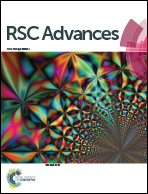Adsorption enhancement of methylene blue dye at kaolinite clay–water interface influenced by electrolyte solutions†
Abstract
The contamination of surface water by dyes released from the effluent of textile industries is a major environmental concern. Adsorption is a cheap and easy separation technique to remove dyes from the effluent water. In this study, the adsorption behaviors of a widely used cationic dye, methylene blue (MB), on kaolinite clay surface in the presence and absence of electrolytes have been reported. The adsorption isotherms of MB in the absence of electrolytes follow the Langmuir model, however, in the presence of electrolytes they follow the Freundlich model. At a constant dye concentration (below the saturation equilibrium concentration), the dye adsorption increases linearly along with the increasing ionic strength of the electrolyte solutions. Among the four electrolytes (NaCl, CaCl2, Na2SO4, Na2HPO4) studied here, Na2HPO4 has the highest adsorption enhancement ability, ∼127% with respect to that of pure MB at a 2 mM initial concentration. This study shows that the adsorption capacity of kaolinite clay can be enhanced significantly by the use of electrolytes, which is very useful for the remediation of dye contaminated waste water.


 Please wait while we load your content...
Please wait while we load your content...